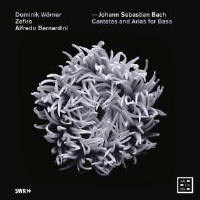Texte paru dans: / Appeared in: |
|
|
Reviewer: J.
F. Weber
The long-popular coupling of
two popular bass cantatas has developed in the CD era into a threesome of
bass cantatas (Fanfare 41:5). Now, just as Michael Volle’s disc just
reviewed there added three sinfonias to the three cantatas, this disc adds
three bass arias selected from other cantatas, one aria placed after each
cantata. Dominik Wörner is familiar from Rudolf Lutz’s recordings, though
not in BWV 56 or 158, which have already appeared. Just six years ago, he
recorded these three cantatas, filled out with BWV 203 (37:5). The same four
cantatas sung by Klaus Mertens were reisssued on Challenge 72283 (32:2) from
the original issues in the complete set under Ton Koopman. Masaaki Suzuki
also offered a different coupling: BWV 56 and 158 sung by Peter Kooij, with
BWV 82a and 84 sung by Carolyn Sampson. Bernardini is not a familiar name to
me, though he has already recorded four cantatas with Wörner (see 40:6 for
three of them and 39:6 for another), along with many other discs reviewed
here. He may be better known as an oboist.
The program leads off with the
masterly BWV 82, the first of these works to be recorded (by Hans Hotter in
1950). Bernardini’s oboe in the opening movement is meltingly lovely. The
final version of 1747–48 in C Minor is used here, not an alternative that I
was aware of. The central aria in BWV 56, also given to bass, oboe, and
continuo, is tossed off with ultimate skill. The chorales are sung one voice
to a part (the three additional singers include the fine countertenor Franz
Vitzthum), and fewer than a dozen players handle all the instrumental parts.
The sessions lasted four days, suggesting that a lot of care went into this
disc. I never noticed before that BWV 82 is sometimes spelled Ich habe
genung, as here and elsewhere. The notes by the eminent scholar Peter Wollny are especially revealing. After discussing Bach’s perennial difficulties in recruiting and training singers and players, six singers are enumerated who sang bass in Bach’s choir, including his future son-in-law Johann Christoph Altnickol, who became a composer and died before turning 40. The earliest of the six singers (1725–27), J. C. S. Lipsius, sang the first performances of both BWV 56 and 82. (Altnickol sang BWV 82 in a later performance.) The notes then discuss Bach’s use of the oboe as a solo instrument, since it occurs in all three of these cantatas and in all three arias. Clearly the singer and oboist/conductor were in their element as they made this disc. While it would be tempting to declare this a first choice, there are simply too many fine bass soloists on records, as noted earlier (41:5); that list of couplings of these cantatas failed to include the reissue of Mertens/Koopman noted above. The quality of the new disc is superb; only a few CDs offer such a quantity of music, and no one will be unhappy to have this disc unless the one-voice-per-part school of thought is anathema. | |
|
|
|
|
|
|
|
Cliquez l'un ou l'autre
bouton pour découvrir bien d'autres critiques de CD |
|




